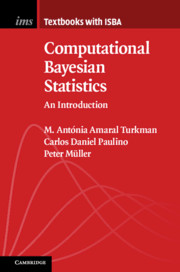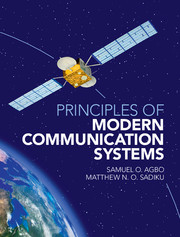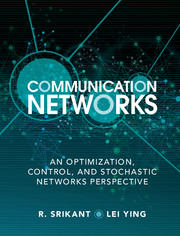Refine listing
Actions for selected content:
9096 results in Communications, Signal Processing and Information Theory
6 - Markov Chain Monte Carlo Methods
-
- Book:
- Computational Bayesian Statistics
- Published online:
- 18 February 2019
- Print publication:
- 28 February 2019, pp 90-128
-
- Chapter
- Export citation
Preface
-
- Book:
- Computational Bayesian Statistics
- Published online:
- 18 February 2019
- Print publication:
- 28 February 2019, pp ix-xii
-
- Chapter
- Export citation
Preface to the English Version
-
- Book:
- Computational Bayesian Statistics
- Published online:
- 18 February 2019
- Print publication:
- 28 February 2019, pp viii-viii
-
- Chapter
- Export citation
3 - Bayesian Inference in Basic Problems
-
- Book:
- Computational Bayesian Statistics
- Published online:
- 18 February 2019
- Print publication:
- 28 February 2019, pp 28-42
-
- Chapter
- Export citation
References
-
- Book:
- Computational Bayesian Statistics
- Published online:
- 18 February 2019
- Print publication:
- 28 February 2019, pp 232-240
-
- Chapter
- Export citation
Appendix A - Probability Distributions
-
- Book:
- Computational Bayesian Statistics
- Published online:
- 18 February 2019
- Print publication:
- 28 February 2019, pp 224-228
-
- Chapter
- Export citation
8 - Methods Based on Analytic Approximations
-
- Book:
- Computational Bayesian Statistics
- Published online:
- 18 February 2019
- Print publication:
- 28 February 2019, pp 150-171
-
- Chapter
- Export citation
9 - Software
-
- Book:
- Computational Bayesian Statistics
- Published online:
- 18 February 2019
- Print publication:
- 28 February 2019, pp 172-223
-
- Chapter
- Export citation
Contents
-
- Book:
- Computational Bayesian Statistics
- Published online:
- 18 February 2019
- Print publication:
- 28 February 2019, pp v-vii
-
- Chapter
- Export citation
5 - Model Assessment
-
- Book:
- Computational Bayesian Statistics
- Published online:
- 18 February 2019
- Print publication:
- 28 February 2019, pp 70-89
-
- Chapter
- Export citation
4 - Inference by Monte Carlo Methods
-
- Book:
- Computational Bayesian Statistics
- Published online:
- 18 February 2019
- Print publication:
- 28 February 2019, pp 43-69
-
- Chapter
- Export citation
Frontmatter
-
- Book:
- Computational Bayesian Statistics
- Published online:
- 18 February 2019
- Print publication:
- 28 February 2019, pp i-iv
-
- Chapter
- Export citation
Index
-
- Book:
- Computational Bayesian Statistics
- Published online:
- 18 February 2019
- Print publication:
- 28 February 2019, pp 241-243
-
- Chapter
- Export citation
Appendix B - Programming Notes
-
- Book:
- Computational Bayesian Statistics
- Published online:
- 18 February 2019
- Print publication:
- 28 February 2019, pp 229-231
-
- Chapter
- Export citation
7 - Model Selection and Trans-dimensional MCMC
-
- Book:
- Computational Bayesian Statistics
- Published online:
- 18 February 2019
- Print publication:
- 28 February 2019, pp 129-149
-
- Chapter
- Export citation
2 - Representation of Prior Information
-
- Book:
- Computational Bayesian Statistics
- Published online:
- 18 February 2019
- Print publication:
- 28 February 2019, pp 17-27
-
- Chapter
- Export citation
1 - Bayesian Inference
-
- Book:
- Computational Bayesian Statistics
- Published online:
- 18 February 2019
- Print publication:
- 28 February 2019, pp 1-16
-
- Chapter
-
- You have access
- Export citation

Computational Bayesian Statistics
- An Introduction
-
- Published online:
- 18 February 2019
- Print publication:
- 28 February 2019

Principles of Modern Communication Systems
-
- Published online:
- 01 February 2019
- Print publication:
- 06 February 2017
-
- Textbook
- Export citation

Communication Networks
- An Optimization, Control, and Stochastic Networks Perspective
-
- Published online:
- 30 January 2019
- Print publication:
- 14 November 2013
-
- Textbook
- Export citation
